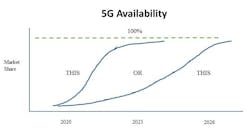The new 5G protocol is in the news virtually every day, with proclamations that encompass everything from cellphones to autonomous vehicles to thermostats. One might already believe that if you don’t own a 5G device, you clearly aren’t “In Style.”
Soooo, marketing claims 5G is pervasive. The question is when: 2020 or is it 2025?
First, let’s define 5G also known as 5G New Radio, or 5G NR.
- There is sub-6-GHz 5G for the cellphone protocol that requires LTE: 5G NSA.
- There is sub-6-GHz standalone 5G: 5G SA.
- There is 20- to 60-GHz 5G: 5G mmWave.
One June 2019 forecast made by Canalys has global 5G smartphone shipments crossing 4G smartphone shipments in 2023 (see figure).
In evaluating whether 5G is ready for “prime time” in any of its incarnations, one must one must look into several areas:
- What is the status of the 5G standards?
- What is the status of technologies in the various frequency spectrums?
- What is the status of 5G in the geopolitical arena?
- What is the status of the component suppliers?
There have been 5G protocols published by various organizations since 2012. However, the initial release of a 5G standard by the 3GPP (“Third Generation Partnership Project” international standards committee) was in 2017. The release (R15 NSA) addressed “non-standalone” 5G, which is 5G coexisting with LTE.
In 2018, 3GPP issued an updated version of R15 for standalone 5G (R15 SA). Then 3GPP released another version of R15 in mid-2019 to address outstanding issues from R15 SA. R16, considered to be the first “full” 5G standard, is scheduled for release in mid-2020. While the scope for R17 has not yet been agreed to, it’s intended to address the enhancements needed for reliable operation in 20+ GHz for autonomous vehicles, commercial industry connections, etc. Sounds like there might be a possibility that coming updates could affect the silicon implementations of 5G and maybe obsolete some implementations?
Dealing with Data Rates
A significant enhancement in 5G over the previous protocols (4G, 3G, WCDMA, CDMA, and GSM) is its increased data rates, which allow it to connect a variety of devices above and beyond traditional smartphone functions. Devices for industrial IoT, autonomous vehicles, and industrial connectivity are thought to depend on the increased data rates supplied by 5G sub-6-GHz and the millimeter-wave (mmWave) portion of the 5G protocol; that is, frequencies in the 20- to 60-GHz range.
However, technical issues must be considered in the utilization of mmWave. For example, mmWave frequencies travel relatively small distances and don’t easily penetrate obstacles such as walls. Plus, they consume a considerable amount of transmit power, providing additional challenges for battery-operated devices. Even the sub-6-GHz versions have technical issues in that the 5G target “air time” latency is 1 to 4 ms.
Unfortunately, the equipment currently shipping (2019) is testing at 8- to 12-ms latency. Some providers report that the latency is really around 30 ms when the server latency is added to the “air time” latency, leaving mmWave-compatible products to still be developed.
Given the evolving standards and the technical questions surrounding mmWave (and even sub-6-GHz), what’s the status of the chipsets/components required to build a 5G product? As expected, the typical RF component suppliers are all providing 5G solutions: Avago/Broadcom, Huawei, MediaTek, Murata/pSemi (previously known as Peregrine), Qualcomm, Qorvo, Samsung, and Skyworks. However, as of this writing, they all appear to be providing components that focus only(?) on the sub-6-GHz frequency bands.
The geopolitical situation relative to 5G also adds confusion to the 5G timeline. Some countries have totally accepted 5G, its standards, and its implementers. Other counties haven’t accepted the 5G standards and/or the implementers, while others are still in the “deciding” stage. It could be interesting “driving” your autonomous vehicle from a country that supports 5G to one that doesn’t support all providers.
Several 5G market analyzers place the current worldwide market at approximately $40B (USD) and growing by a 57% CAGR to over $1T (USD) by 2025. With the standards still evolving, what are the likely changes that will occur by 2025?
So, when would you be willing to spend ±1,000 dollars for a 5G ONLY smartphone or commit your manufacturing floor to 5G mmWave connectivity? 2020?
Would you like to see what components are shipping in the current set of 5G devices? Are those devices really using 5G or falling back to 4G/LTE?
What 5G stocks would you like to invest in? What would “Motley Fool” recommend?
Ted Scardamalia is Co-Founder and President of MSW Analytics Inc.
About the Author
Ted Scardamalia
Co-Founder & President, MSW Analytics Inc.
Ted Scardamalia’s background ranges from being a Senior Manager in a Fortune 50 company to raising $15.6M in Venture Capital for an eight-person startup.

